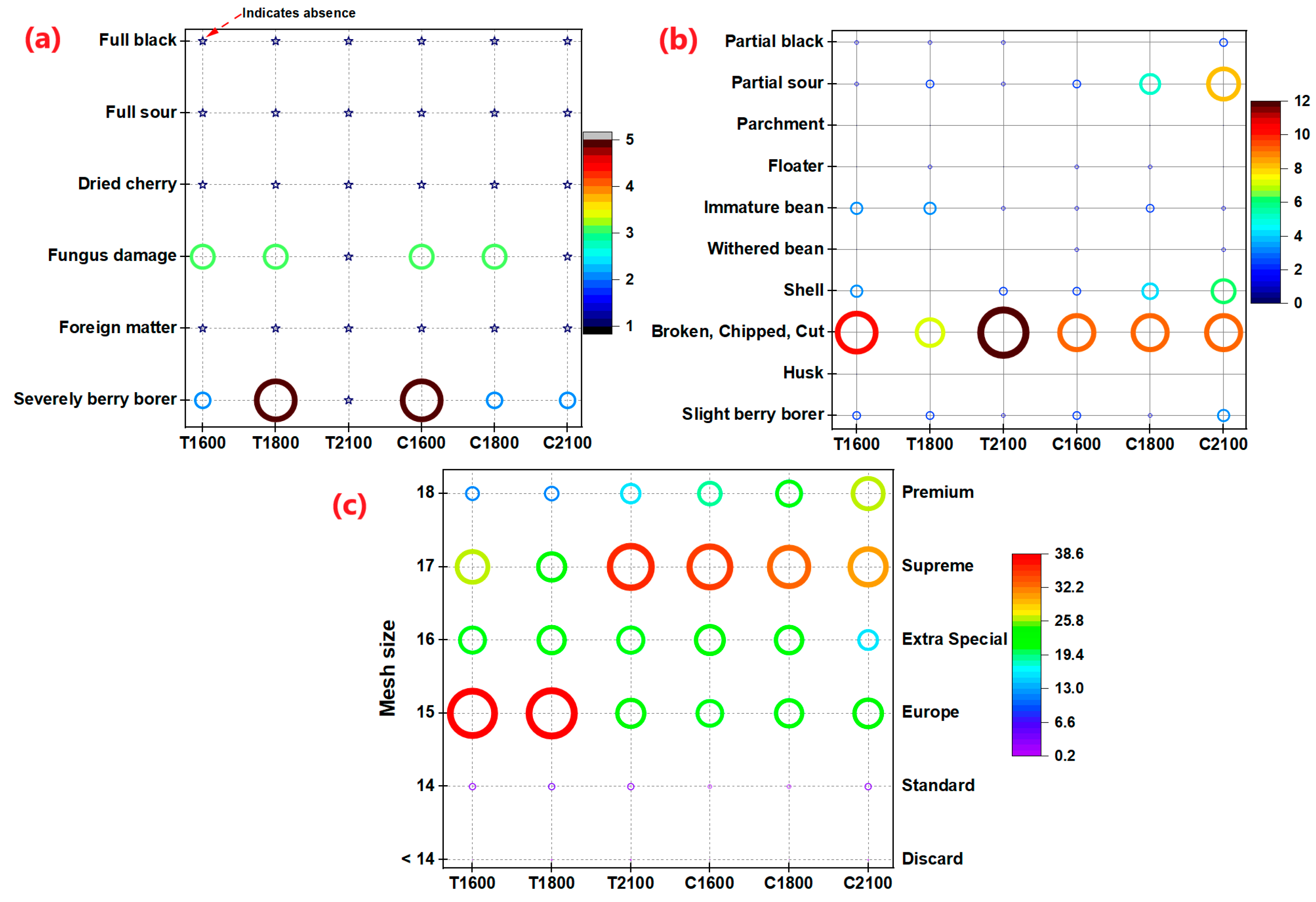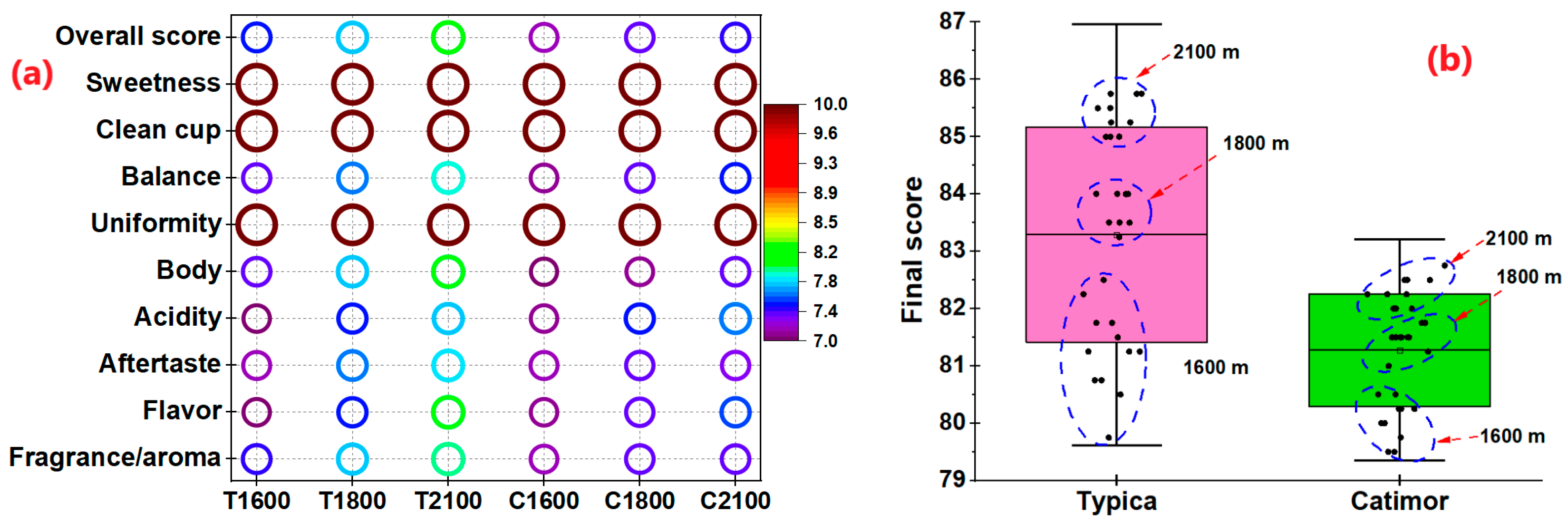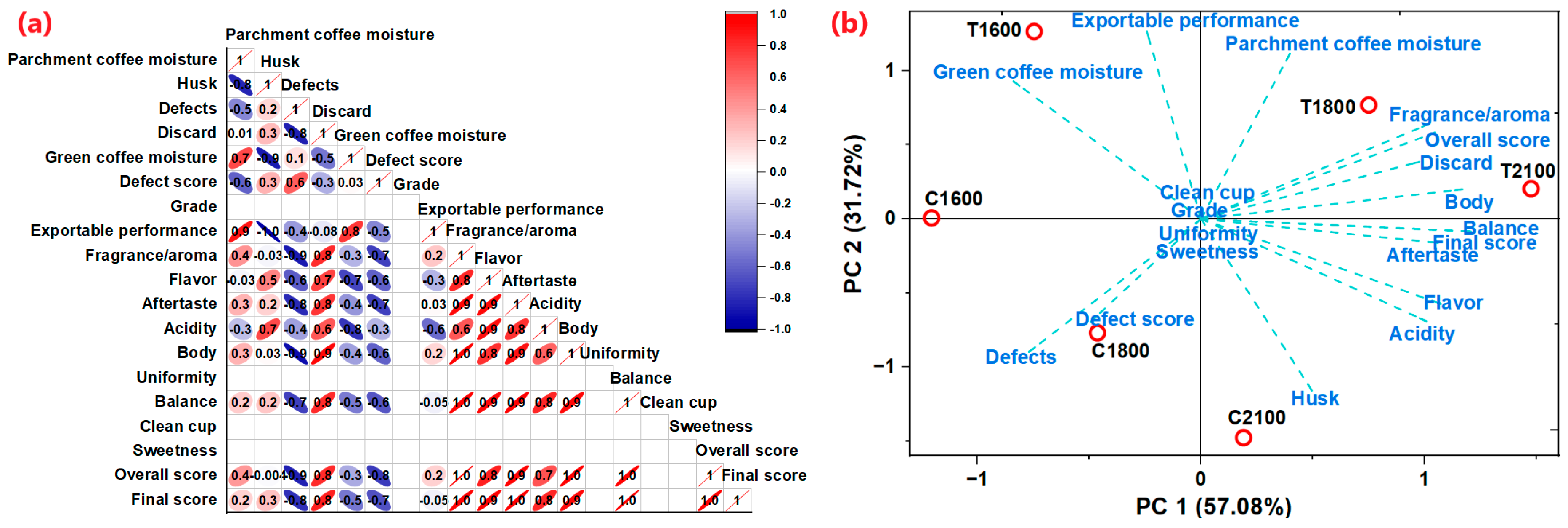Impact of Altitudinal Gradients on Exportable Performance, and Physical and Cup Quality of Coffee (Coffea arabica L.) Grown in Inter-Andean Valley
Abstract
1. Introduction
2. Materials and Methods
2.1. Raw Materials and Crop Field Characteristics
2.2. Physical Quality of Parchment Coffee
2.3. Exportable Yield Determination
2.4. Preparation of Coffee in Cup
2.5. Preparation of Drinkable Coffee
2.6. Coffee Cupping
2.7. Statistical Data Processing
3. Results and Discussion
3.1. Physical Properties of Parchment and Green Coffee
3.2. Primary and Secondary Defects
3.3. Bean Size
3.4. Exportable Performance
3.5. Sensory Quality of Coffee in the Cup
3.6. Multivariate Analysis of the Physical and Sensory Quality of Coffee
4. Conclusions
Author Contributions
Funding
Data Availability Statement
Acknowledgments
Conflicts of Interest
References
- Paterek, R.; Geoghegan, S.; Creaven, B.S.; Power, A. Coffee: Lighting Its Complex Ground Truth and Percolating Its Molecular Brew. Beverages 2024, 10, 119. [Google Scholar] [CrossRef]
- Freitas, V.V.; Borges, L.L.R.; Vidigal, M.C.T.R.; dos Santos, M.H.; Stringheta, P.C. Coffee: A comprehensive overview of origin, market, and the quality process. Trends Food Sci. Technol. 2024, 146, 104411. [Google Scholar] [CrossRef]
- Garcia, A.; Dávila, J.; Wong, L. Framework to improve the traceability of the coffee production chain in peru by applying a blockchain architecture. In Proceedings of the 2022 32nd Conference of Open Innovations Association (FRUCT), Tampere, Finland, 9–11 November 2022; pp. 93–101. [Google Scholar]
- Gois, T.C.; Thomé, K.M.; Balogh, J.M. Behind a cup of coffee: International market structure and competitiveness. Compet. Rev. Int. Bus. J. 2023, 33, 993–1009. [Google Scholar] [CrossRef]
- Rubio-Jovel, K. Coffee production networks in Costa Rica and Colombia: A systems analysis on voluntary sustainability standards and impacts at the local level. J. Clean. Prod. 2024, 445, 141196. [Google Scholar] [CrossRef]
- Tulet, J.-C. Peru as a new major actor in Latin American coffee production. Lat. Am. Perspect. 2010, 37, 133–141. [Google Scholar] [CrossRef]
- Salas López, R.; Gómez Fernández, D.; Silva López, J.O.; Rojas Briceño, N.B.; Oliva, M.; Terrones Murga, R.E.; Iliquín Trigoso, D.; Barboza Castillo, E.; Barrena Gurbillón, M.Á. Land suitability for coffee (Coffea arabica) growing in Amazonas, Peru: Integrated use of AHP, GIS and RS. ISPRS Int. J. Geo-Inf. 2020, 9, 673. [Google Scholar] [CrossRef]
- Pham, Y.; Reardon-Smith, K.; Mushtaq, S.; Cockfield, G. The impact of climate change and variability on coffee production: A systematic review. Clim. Chang. 2019, 156, 609–630. [Google Scholar] [CrossRef]
- Lechthaler, F.; Vinogradova, A. The climate challenge for agriculture and the value of climate services: Application to coffee-farming in Peru. Eur. Econ. Rev. 2017, 94, 45–70. [Google Scholar] [CrossRef]
- Yllescas, J.; Vega, H.; De La Cruz, P.; Pantoja, J.; Cancho-Rodriguez, E. System Based on Market Segmentation to Improve the Export of Peruvian Coffee. Eur. Bus. Manag. 2022, 8, 55–61. [Google Scholar] [CrossRef]
- Duran, R.F.A.; Sernaque, F.R.C.; Sirlopu, J.R.R.; Moncada, J.J.R. Forecasting the export competitiveness of Peruvian coffee in major importing countries usingautoregressive integrated moving average modeling. Rev. Científica Pakamuros 2024, 12, 126–137. [Google Scholar] [CrossRef]
- Córdova, Y.M.P.; Villena, F.C.; Cabrera, M.A.L.; Juwau, J.M.; Rodríguez, V.H.P. Peru-Germany: Impact of COVID-19 on coffee agro-exports 2018–2021. Sapienza Int. J. Interdiscip. Stud. 2022, 3, 159–174. [Google Scholar] [CrossRef]
- INACAL. Guide for the Implementation of the Peruvian Technical Standard NTP 209.310:2019. PERGAMINO COFFEE. Requirements; INACAL: Lima, Peru, 2021. [Google Scholar]
- INACAL. Guide for the Implementation of the Peruvian Technical Standard NTP 209.027:2018. COFFEE. Green Coffee. Requirements; INACAL: Lima, Peru, 2021. [Google Scholar]
- SCAA. Protocols Cupping Speciality Coffee Speciality Coffee Association of America; SCAA: Irvine, CA, USA, 2015; pp. 1–7. [Google Scholar]
- Corrêa, P.C.; Oliveira, G.H.H.; Rodrigues, P.L.; Campos, S.C.; Botelho, F.M. Hygroscopic equilibrium and physical properties evaluation affected by parchment presence of coffee grain. Span. J. Agric. Res. 2010, 8, 694–702. [Google Scholar] [CrossRef]
- Taveira, J.H.D.S.; Borém, F.M.; Da Rosa, S.D.V.F.; Oliveira, P.D.; Giomo, G.S.; Isquierdo, E.P.; Fortunato, V.A. Post-harvest effects on beverage quality and physiological performance of coffee beans. Afr. J. Agric. Res. 2015, 10, 1457–1466. [Google Scholar] [CrossRef]
- Adriá, F.; Vorsitzender, E. Coffee Sapiens: Innovation Through Understanding; Phaidon: New York, NY, USA, 2019. [Google Scholar]
- Vanesa, D.; Ana, P. Occurrence of Ochratoxin A in coffee beans, ground roasted coffee and soluble coffee and method validation. Food Control 2013, 30, 675–678. [Google Scholar] [CrossRef]
- Esquivel, P.; Viñas, M.; Steingass, C.B.; Gruschwitz, M.; Guevara, E.; Carle, R.; Schweiggert, R.M.; Jiménez, V.M. Coffee (Coffea arabica L.) by-products as a source of carotenoids and phenolic compounds—Evaluation of varieties with different peel color. Front. Sustain. Food Syst. 2020, 4, 590597. [Google Scholar] [CrossRef]
- Constantino, L.M.; Gil, Z.N.; Montoya, E.C.; Benavides, P. Coffee berry borer (Hypothenemus hampei) emergence from ground fruits across varying altitudes and climate cycles, and the effect on coffee tree infestation. Neotrop. Entomol. 2021, 50, 374–387. [Google Scholar] [CrossRef]
- Whittaker, L.; González-Moreno, P.; Lowry, A.; Vélez, L.J.; Aristizábal, V.; Aristizábal, L.F.P.; Edgington, S.; Murphy, S.T. The effect of an altitudinal gradient on the abundance and phenology of the coffee berry borer (Hypothenemus hampei)(ferreri)(Coleoptera: Scolytidae) in the Colombia Andes. Int. J. Pest Manag. 2024, 1–12. [Google Scholar] [CrossRef]
- Silva, L.C.F.; Pereira, P.V.R.; da Cruz, M.A.D.; Costa, G.X.R.; Rocha, R.A.R.; Bertarini, P.L.L.; do Amaral, L.R.; Gomes, M.S.; Santos, L.D. Enhancing sensory quality of coffee: The impact of fermentation techniques on Coffea arabica cv. Catiguá MG2. Foods 2024, 13, 653. [Google Scholar] [CrossRef] [PubMed]
- Bilen, C.; El Chami, D.; Mereu, V.; Trabucco, A.; Marras, S.; Spano, D. A systematic review on the impacts of climate change on coffee agrosystems. Plants 2022, 12, 102. [Google Scholar] [CrossRef]
- Alvarado, C.W.; Bobadilla, L.G.; Valqui, L.; Valqui, G.S.; Valqui-Valqui, L.; Vigo, C.N.; Vásquez, H.V. Characterization of Coffea arabica L. parent plants and physicochemical properties of associated soils, Peru. Heliyon 2022, 8, e10895. [Google Scholar] [CrossRef]
- Osorio Pérez, V.; Pabón Usaquén, J.P.; Calderón Tulcán, P.A.; Imbachí Quinchua, L.C. Physical and sensory quality and chemical composition of coffee grown in the Department of Huila. Rev. Cenicafé 2021, 72, e72201. [Google Scholar] [CrossRef]
- Coayla, E.; Bedón, Y. Peruvian organic agro-exports, climate change and food security. Rev. Econ. Sociol. Rural 2024, 62, e282838. [Google Scholar] [CrossRef]
- Montero-Mora, A.; Badia-Miró, M. Mild Arabica coffee trade at a time of market regulation. Econ. Hist. Dev. Reg. 2024, 39, 196–217. [Google Scholar] [CrossRef]
- Ninaquispe, J.C.M.; María, A.P.S.; Vallejo, I.A.O. Commercial dynamics of Peruvian coffee exports to the European Union 2017-2021. Alfa Rev. Investig. Cienc. Agronómicas Vet. 2023, 7, 175–183. [Google Scholar]
- Pancsira, J. International Coffee Trade: A literature review. J. Agric. Inform. 2022, 13, 26–35. [Google Scholar] [CrossRef]
- Prilliadi, H.; Birinci, A. A Study on Determinants of Coffee Export from Indonesia to The United States of America. J. Inst. Sci. Technol. 2023, 13, 2174–2184. [Google Scholar] [CrossRef]
- Merga Sakata, W.; Gebreselassie Abtew, W.; Garedew, W. Organoleptic quality attributes and their association with morphological traits in Arabica coffee (Coffea arabica L.) genotypes. J. Food Qual. 2022, 2022, 2906424. [Google Scholar] [CrossRef]
- Coelho, E.G.; Bertarini, P.L.L.; Gomes, M.S.; Amaral, L.R.; Zotarelli, M.F.; Santos, L.D.; Santana, R.C. Physicochemical and Sensory properties of Arabica coffee beans of Arara cv. dried using different methods. Foods 2024, 13, 642. [Google Scholar] [CrossRef] [PubMed]
- Simmer, M.M.B.; Soares da Silva, M.d.C.; Pereira, L.L.; Moreira, T.R.; Guarçoni, R.C.; Veloso, T.G.R.; da Silva, I.M.R.; Entringer, T.L.; Kasuya, M.C.M.; da Luz, J.M.R. Edaphoclimatic conditions and the soil and fruit microbiota influence on the chemical and sensory quality of the coffee beverage. Eur. Food Res. Technol. 2022, 248, 2941–2953. [Google Scholar] [CrossRef]
- Getachew, M.; Tolassa, K.; De Frenne, P.; Verheyen, K.; Tack, A.J.M.; Hylander, K.; Ayalew, B.; Boeckx, P. The relationship between elevation, soil temperatures, soil chemical characteristics, and green coffee bean quality and biochemistry in southwest Ethiopia. Agron. Sustain. Dev. 2022, 42, 61. [Google Scholar] [CrossRef]
- Salazar, J.C.S.; Rodríguez Burgos, E.; Duran-Bautista, E.H. Effect of culture conditions, the chemical characteristics of soil and grain handling in the sensory attributes of coffee (Coffea arabica L.) in cup. Acta Agron. 2015, 64, 342–348. [Google Scholar]
- Mintesnot, A.; Dechassa, N.; Mohammed, A. Association of Arabica coffee quality attributes with selected soil chemical properties. East Afr. J. Sci. 2015, 9, 73–84. [Google Scholar]
- Gamonal, L.E.; Vallejos-Torres, G.; López, L.A. Sensory analysis of four cultivars of coffee (Coffea arabica L.), grown at different altitudes in the San Martin region-Peru. Ciência Rural 2017, 47, e20160882. [Google Scholar] [CrossRef]
- Velásquez, S.; Banchón, C.; Chilán, W.; Guerrero-Casado, J. Effect of three post-harvest methods at different altitudes on the organoleptic quality of C. canephora coffee. Beverages 2022, 8, 83. [Google Scholar] [CrossRef]
- Silveira, A.d.S.; Pinheiro, A.C.T.; Ferreira, W.P.M.; Silva, L.J.d.; Rufino, J.L.d.S.; Sakiyama, N.S. Sensory analysis of specialty coffee from different environmental conditions in the region of Matas de Minas, Minas Gerais, Brazil. Rev. Ceres 2016, 63, 436–443. [Google Scholar] [CrossRef]
- Hu, R.; Xu, F.; Chen, X.; Kuang, Q.; Xiao, X.; Dong, W. The Growing Altitude Influences the Flavor Precursors, Sensory Characteristics and Cupping Quality of the Pu’er Coffee Bean. Foods 2024, 13, 3842. [Google Scholar] [CrossRef] [PubMed]
- da Silva Oliveira, E.C.; da Luz, J.M.R.; de Castro, M.G.; Filgueiras, P.R.; Guarçoni, R.C.; de Castro, E.V.R.; da Silva, M.d.C.S.; Pereira, L.L. Chemical and sensory discrimination of coffee: Impacts of the planting altitude and fermentation. Eur. Food Res. Technol. 2022, 248, 659–669. [Google Scholar] [CrossRef]
- Wondimkun, Y.W.; Emire, S.A.; Esho, T.B. Investigation of physical and sensory properties of Ethiopian specialty dry processed green coffee beans. Acta Univ. Cibiniensis. Ser. E Food Technol. 2020, 24, 39–48. [Google Scholar] [CrossRef]
- Gonzalez-Sanchez, B.; Sandoval-Gonzalez, O.; Flores-Cuautle, J.d.J.A.; Landeta-Escamilla, O.; Portillo-Rodriguez, O.; Aguila-Rodriguez, G. A Study of the Physical Characteristics and Defects of Green Coffee Beans That Influence the Sensory Notes Using Machine Learning Models. Processes 2023, 12, 18. [Google Scholar] [CrossRef]
- Vega, A.; De León, J.A.; Reyes, S.M.; Gallardo, J.M. Mathematical model to determine the correlation between physicochemical parameters and the sensory quality of Panama Geisha and Pacamara coffee. Inf. Tecnológica 2021, 32, 89–100. [Google Scholar] [CrossRef]
- Barbosa, M.d.S.G.; dos Santos Scholz, M.B.; Kitzberger, C.S.G.; de Toledo Benassi, M. Correlation between the composition of green Arabica coffee beans and the sensory quality of coffee brews. Food Chem. 2019, 292, 275–280. [Google Scholar] [CrossRef]
- Worku, M.; De Meulenaer, B.; Duchateau, L.; Boeckx, P. Effect of altitude on biochemical composition and quality of green arabica coffee beans can be affected by shade and postharvest processing method. Food Res. Int. 2018, 105, 278–285. [Google Scholar] [CrossRef]
- Tolessa, K.; D’Heer, J.; Duchateau, L.; Boeckx, P. Influence of growing altitude, shade and harvest period on quality and biochemical composition of Ethiopian specialty coffee. J. Sci. Food Agric. 2017, 97, 2849–2857. [Google Scholar] [CrossRef]
- Sarmiento-Soler, A.; Rötter, R.P.; Hoffmann, M.P.; Jassogne, L.; van Asten, P.; Graefe, S.; Vaast, P. Disentangling effects of altitude and shade cover on coffee fruit dynamics and vegetative growth in smallholder coffee systems. Agric. Ecosyst. Environ. 2022, 326, 107786. [Google Scholar] [CrossRef]




| Sample | pH (1:1) | EC (1:1) (µS/cm) | CaCO3 (%) | OM (%) | P (ppm) | K (ppm) | Composition | CEC | Ca2+ | Mg2+ | K+ | Na+ | Al3+ + H+ | |||
|---|---|---|---|---|---|---|---|---|---|---|---|---|---|---|---|---|
| Sand (%) | Silt (%) | Clay (%) | Texture | meq/100 g | ||||||||||||
| 1600 | 6.61 | 280 | 0.00 | 4.71 | 18.24 | 191 | 46 | 30 | 23 | L | 21.02 | 16.21 | 1.44 | 0.57 | 0.19 | 0.04 |
| 1800 | 6.56 | 310 | 0.00 | 4.88 | 20.3 | 185 | 45 | 32 | 23 | L | 20.00 | 15.20 | 1.38 | 0.53 | 0.17 | 0.00 |
| 2100 | 5.53 | 170 | 0.00 | 5.52 | 13.7 | 136 | 51 | 26 | 23 | L.C.S. | 18.08 | 9.78 | 1.52 | 0.42 | 0.15 | 0.10 |
| Variety | Parchment Coffee Moisture (%) | Husk or Shrinkage (%) | Defects (%) | Discard (%) | Green Coffee Moisture (%) | |||||||||||||||
|---|---|---|---|---|---|---|---|---|---|---|---|---|---|---|---|---|---|---|---|---|
| ±s | CV | * | ±s | CV | * | ±s | CV | * | ±s | CV | * | ±s | CV | * | ||||||
| T1600 | 9.11 | 0.025 | 0.28 | a | 16.22 | 0.16 | 1.00 | c | 1.39 | 0.27 | 19.21 | a | 0.41 | 0.11 | 27.61 | d | 9.03 | 0.06 | 0.64 | a |
| T1800 | 9.13 | 0.029 | 0.32 | a | 17.13 | 0.22 | 1.26 | b | 0.68 | 0.06 | 9.21 | b | 0.86 | 0.13 | 14.95 | a | 8.93 | 0.06 | 0.65 | a |
| T2100 | 9.09 | 0.036 | 0.40 | a | 17.40 | 0.09 | 0.52 | b | 0.63 | 0.11 | 17.80 | b | 0.82 | 0.17 | 20.84 | b | 8.63 | 0.06 | 0.67 | b |
| C1600 | 8.94 | 0.067 | 0.75 | a,b | 17.06 | 0.09 | 0.51 | b | 1.48 | 0.23 | 15.29 | a | 0.25 | 0.05 | 20.00 | e | 8.97 | 0.12 | 1.29 | a |
| C1800 | 9.02 | 0.029 | 0.32 | b | 17.46 | 0.19 | 1.09 | b | 1.84 | 0.26 | 13.93 | a | 0.21 | 0.07 | 34.64 | e | 8.93 | 0.12 | 1.29 | a |
| C2100 | 8.52 | 0.076 | 0.90 | c | 18.67 | 0.29 | 1.55 | a | 1.55 | 0.19 | 12.18 | a | 0.67 | 0.07 | 10.83 | c | 8.47 | 0.06 | 0.68 | b |
| Variety | Defect Score | Grade | Exportable Performance (%) | |||
|---|---|---|---|---|---|---|
| ±s | CV | * | ||||
| T1600 | 4 | 1 | 81.98 | 0.42 | 0.51 | a |
| T1800 | 4 | 1 | 81.33 | 0.04 | 0.05 | a, b |
| T2100 | 2 | 1 | 81.15 | 0.11 | 0.13 | b, c |
| C1600 | 4 | 1 | 81.21 | 0.16 | 0.20 | b |
| C1800 | 4 | 1 | 80.49 | 0.34 | 0.42 | c |
| C2100 | 5 | 1 | 79.12 | 0.20 | 0.26 | d |
Disclaimer/Publisher’s Note: The statements, opinions and data contained in all publications are solely those of the individual author(s) and contributor(s) and not of MDPI and/or the editor(s). MDPI and/or the editor(s) disclaim responsibility for any injury to people or property resulting from any ideas, methods, instructions or products referred to in the content. |
© 2025 by the authors. Licensee MDPI, Basel, Switzerland. This article is an open access article distributed under the terms and conditions of the Creative Commons Attribution (CC BY) license (https://creativecommons.org/licenses/by/4.0/).
Share and Cite
Choque-Quispe, K.; Reynoso-Canicani, D.D.; Aguirre-Landa, J.P.; Agreda Cerna, H.W.; Villegas Casaverde, M.; Prado Canchari, A.; Mescco Cáceres, E.; Quispe Chambilla, L.; Carrión Sánchez, H.M.; Torres Flores, Y.; et al. Impact of Altitudinal Gradients on Exportable Performance, and Physical and Cup Quality of Coffee (Coffea arabica L.) Grown in Inter-Andean Valley. Resources 2025, 14, 136. https://doi.org/10.3390/resources14090136
Choque-Quispe K, Reynoso-Canicani DD, Aguirre-Landa JP, Agreda Cerna HW, Villegas Casaverde M, Prado Canchari A, Mescco Cáceres E, Quispe Chambilla L, Carrión Sánchez HM, Torres Flores Y, et al. Impact of Altitudinal Gradients on Exportable Performance, and Physical and Cup Quality of Coffee (Coffea arabica L.) Grown in Inter-Andean Valley. Resources. 2025; 14(9):136. https://doi.org/10.3390/resources14090136
Chicago/Turabian StyleChoque-Quispe, Katia, Delma Diana Reynoso-Canicani, John Peter Aguirre-Landa, Henrry W. Agreda Cerna, Medalit Villegas Casaverde, Alfredo Prado Canchari, Edwin Mescco Cáceres, Lucero Quispe Chambilla, Hilka Mariela Carrión Sánchez, Yasminia Torres Flores, and et al. 2025. "Impact of Altitudinal Gradients on Exportable Performance, and Physical and Cup Quality of Coffee (Coffea arabica L.) Grown in Inter-Andean Valley" Resources 14, no. 9: 136. https://doi.org/10.3390/resources14090136
APA StyleChoque-Quispe, K., Reynoso-Canicani, D. D., Aguirre-Landa, J. P., Agreda Cerna, H. W., Villegas Casaverde, M., Prado Canchari, A., Mescco Cáceres, E., Quispe Chambilla, L., Carrión Sánchez, H. M., Torres Flores, Y., Palomino-Rincón, H., & Choque-Quispe, D. (2025). Impact of Altitudinal Gradients on Exportable Performance, and Physical and Cup Quality of Coffee (Coffea arabica L.) Grown in Inter-Andean Valley. Resources, 14(9), 136. https://doi.org/10.3390/resources14090136









